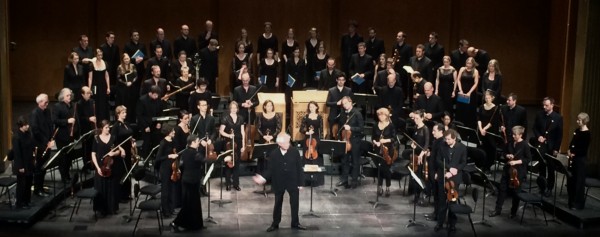St. Matthew Passion with Philippe Herreweghe in Paris
St
. Matthew Passion with Philippe Herreweghe
Review by Henning Høholt
PARIS/FRANCE: The St. Matthew Passion by Johann Sebastian Bach led by Philippe Heereweghe at Theatre des Champes Elysées in Paris was an extraordinary good event. The length inclusive break was 3 hours and 45 minutes as a long opera. As the Evangeliste we enjoyed Maximilian Schmitt and as the Christ Florian Boesch.

Philippe Herreweghe and his ensemble – Orchestre and choire from Collegium Vocale Gent. at Theatre des Champs Élysées for the St. Matthew Passion.
The music is demanding for the participants, both for the choir, orchestra (the audience) and for the soloists, among them the most importent role the Evangeliste, brilliant sung and played by the wonderful and powerfull tenor Maximilian Schmitt, it seems like the textual performance came from his heart, he seemed to know every thing about the history that he communicated to us, and his interpretation (in German) was brilliant.His counterpart in this Oratorium is the voice of Christ excellent presented by the bassbaryton Florian Boesch.
Orchestra and choire from Collegium Vocale Gent, under the splendid direction of Philippe Herreweghe, who was in the centre, with the double orchestra and double choir, the soloists, two sopranos,Dorothee Mields and Grace Davidson, two countertenors, Damien Guillou and Alex Potter, two tenors Renaud Van Mechelen and Thomas Hobbs, and the basse Peter Koolj and baryton Tobias Berndt did a very good job, taking care of the other different demanding soloparts. These soloparts are demanding with large recitatives and arias, and in between also playing the different roles in the piece, in addition to singing in the choir from where 6 more soloists was stepping out. It was specially clear by the bass who had most to sing in the first half part.
TheSt Matthew Passion, BWV244, (in German:Matthäus-Passion), is a musical composition from thePassionswritten by Johann Sebastian Bachin 1727 for solo voices, double choirand double orchestra, with librettobyPicander(Christian Friedrich Henrici). It sets chapters 26and 27 of the Gospel of Matthewto music, with interspersedchoralesand arias. It is widely regarded as one of the masterpieces of classical sacred music. The original Latin titlePassio Domini Nostri J.C. Secundum Evangelistam Matthaeum translates to “The Passion of our Lord J[esus] C[hrist] according to the Evangelist Matthew.” It is also rendered in English asSt. Matthew Passionand in German asMatthäuspassion.
Although Bach wrote four (or five) settings of thePassionsonly two have survived; the other is the St
. John Passion. TheSt Matthew Passionwas probably first performed on Good Friday(11 April) 1727)in the Thomaskirchein Leipzig, where Bach was the Kantorof the School andDirectoris Chori musiciof Leipzig. He revised it by 1736, performing it again on 30 March 1736, this time including two organsin the instrumentation. He further revised and performed it again on 24 March 1742. Possibly due to the second organ being under repair, he switched the continuo instrument to harpsichord in Coro II, reinforced the continuo group in Coro II with a viola da gamba, and inserted aripienisoprano in both movements 1 and 29. There is evidence of a further revision in 1743-1746, when the score as we know it originated, but no performance.
St. Matthew Passion is full of beautiful parts. One is of course the famous choral: “Erkenne mich, mein Hüter, Mein Hirte, nimm mich an”.
Another is the famouse soprano aria (no.39):” Erbarme dich, Mein Gott, um meiner Zähren willen”. In this we experienced a wonderful cooperation between the soprano and the 1. violin.
The narration of the Gospel texts are sung by the tenor Evangelist, in Perigueux sung by MARKUS BRUTSCHER,in secco recitative accompanied only by continuo. In Perigueux with an outstanding organist – P- Gallon. Soloists sing the words of various characters, also in recitative; in addition to Jesus, there are named parts for Judas, Peter, two high priests, Pontius Pilate, Pilate’s wife, two witnesses and two ancillae (maids). These are not always sung by all different soloists. The “character” soloists are also often assigned arias and sing with the choirs, a practice not always followed by modern performances. Two duets are sung by a pair of soloists’ representing two simultaneous speakers. A number of passages for several speakers, called turba (crowd) parts, are sung by one of the two choirs or both.
Vox Christi
The words of Jesus, also termed Vox Christi (voice of Christ), usually receive special treatment. Bach created particularly distinctive accompagnato recitatives in this work: they are accompanied not only by continuo but by the entire string section of the first orchestra using long, sustained notes and “highlighting” certain words, thus creating an effect often referred to as Jesus’s “halo”. Only his final words, written in Aramiac, Eli, eli, lama sabachthani (My God, my god, why have you forsaken me?), are sung without this “halo”. In the revision of 1743-1746, it is also these words (the Vox Christi) that receive a sustained continuo part. In all prior versions (1727/1729, 1736, and 1742), the continuo part was sustained in all recitatives.
Some arias and choruses of the St Matthew Passion have a parody connection to the for a periode lost funeral cantata Klagt, Klagt, klagt es aller welt, BWv 244a, composed for the memorial service for Leopold, Prince of Anhalt-Köthen (1729). – Köthener Trauermusic. As we heard , some years ago in Perigueux with Ensemble Pygmalion in a brilliant premiere production conducted by the outstanding conductor Raphael Pichon. But that is another history.
